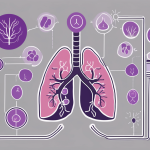Tagrisso (osimertinib) marks a significant advancement in the treatment landscape of Non-Small Cell Lung Cancer (NSCLC), particularly for patients with the EGFR mutation. This innovative medication functions as a tyrosine kinase inhibitor, effectively targeting and impeding the growth of cancer cells harboring specific genetic alterations. With a focus on patients with early-stage to advanced (stage 4) EGFR+ cancer, Tagrisso has demonstrated remarkable efficacy in clinical trials, showcasing improved progression-free survival rates and a promising ability to penetrate the blood-brain barrier—a crucial factor in managing metastases. Despite its groundbreaking impact, managing potential side effects such as skin rash and diarrhea is essential for optimizing patient well-being. Tagrisso stands out among EGFR inhibitors for its targeted action against resistance mutations, notably T790M, offering a beacon of hope for improved long-term outcomes and quality of life for lung cancer patients. As research progresses, Tagrisso’s role in personalized cancer treatment continues to evolve, embodying the shift towards more tailored and effective cancer care strategies.
Tagrisso is a groundbreaking medication that has revolutionized the treatment of lung cancer. This article aims to provide a comprehensive understanding of Tagrisso’s mechanism of action, its role in targeted therapy, clinical trials, managing side effects, long-term benefits, and its comparison with other EGFR inhibitors. We will also discuss how Tagrisso empowers patients and improves their quality of life, as well as its effectiveness in early stage and stage 4 EGFR+ cancer.
Understanding the Mechanism of Action of Tagrisso
Tagrisso, also known as osimertinib, is a tyrosine kinase inhibitor that specifically targets mutated forms of the epidermal growth factor receptor (EGFR) found in non-small cell lung cancer (NSCLC). It blocks the signals that promote cancer cell growth and division, effectively slowing down tumor progression.
Non-small cell lung cancer (NSCLC) is the most common type of lung cancer, accounting for approximately 85% of all cases. It is a complex disease with various subtypes, and one of the key drivers of NSCLC is the mutation in the EGFR gene. This mutation leads to the overactivation of the EGFR pathway, resulting in uncontrolled cell growth and division.
Tagrisso, with its unique mechanism of action, offers a ray of hope for patients with NSCLC. By specifically targeting the mutated forms of EGFR, it disrupts the signaling pathways that drive cancer cell proliferation. This targeted approach not only slows down tumor growth but also minimizes the side effects associated with traditional chemotherapy.
One of the remarkable features of Tagrisso is its ability to overcome a common resistance mutation known as T790M. This mutation often develops in NSCLC patients who have been treated with other EGFR inhibitors, such as gefitinib or erlotinib. T790M mutation acts as a shield, preventing these inhibitors from effectively blocking the EGFR pathway.
However, Tagrisso has shown exceptional efficacy in inhibiting the T790M mutation, making it a vital weapon in the battle against lung cancer. By binding to the mutated EGFR protein, Tagrisso disrupts the signaling cascade that drives cancer cell growth, effectively overcoming resistance and restoring sensitivity to EGFR inhibitors.
Furthermore, Tagrisso has demonstrated favorable safety and tolerability profiles in clinical trials. Patients receiving Tagrisso reported fewer severe adverse events compared to traditional chemotherapy, improving their quality of life during treatment.
In addition to its efficacy against EGFR mutations, Tagrisso has also shown promise in combination therapies. Researchers are exploring the potential of combining Tagrisso with other targeted therapies or immunotherapies to enhance treatment outcomes and further improve patient survival rates.
Overall, Tagrisso represents a significant advancement in the treatment of NSCLC. Its targeted mechanism of action, ability to overcome resistance mutations, and favorable safety profile make it a valuable option for patients battling this devastating disease. Ongoing research and clinical trials continue to explore the full potential of Tagrisso in improving patient outcomes and bringing us closer to a future where lung cancer is no longer a formidable foe.
The Role of Tagrisso in Targeted Therapy for Lung Cancer
Targeted therapy has transformed the way we approach lung cancer treatment. Tagrisso plays a pivotal role in this revolutionary treatment approach. It is specifically designed to target the underlying genetic mutations responsible for the growth and spread of cancer cells.
By tailoring treatment to the specific genetic makeup of the tumor, Tagrisso offers a more effective and personalized approach. This targeted therapy minimizes damage to healthy cells and maximizes treatment outcomes.
Tagrisso, also known as osimertinib, belongs to a class of drugs called tyrosine kinase inhibitors (TKIs). These drugs work by blocking the activity of certain proteins, known as epidermal growth factor receptor (EGFR) mutations, that are found in some lung cancer cells. EGFR mutations are responsible for the uncontrolled growth and division of cancer cells.
Tagrisso is particularly effective in treating non-small cell lung cancer (NSCLC) that has a specific type of EGFR mutation called T790M. This mutation is responsible for resistance to other EGFR inhibitors, making Tagrisso a valuable option for patients who have not responded to other treatments.
Clinical trials have shown that Tagrisso can significantly improve progression-free survival in patients with advanced NSCLC harboring the T790M mutation. In fact, it has been shown to double the median progression-free survival compared to standard chemotherapy.
One of the key advantages of Tagrisso is its ability to penetrate the blood-brain barrier, a protective barrier that prevents many drugs from reaching the brain. This is particularly important in the treatment of lung cancer, as brain metastases are a common complication. By effectively targeting cancer cells in the brain, Tagrisso offers hope to patients with advanced lung cancer who have developed brain metastases.
Tagrisso is generally well-tolerated, with common side effects including diarrhea, rash, and dry skin. These side effects are usually manageable and can be effectively addressed by healthcare providers. It is important for patients to communicate any side effects they experience to their healthcare team, as they can provide guidance and support.
In conclusion, Tagrisso has revolutionized the field of targeted therapy for lung cancer. By specifically targeting the underlying genetic mutations responsible for cancer cell growth, Tagrisso offers a more personalized and effective treatment approach. Its ability to penetrate the blood-brain barrier and target brain metastases makes it a valuable option for patients with advanced lung cancer. With ongoing research and advancements in targeted therapy, the future looks promising for improving outcomes in lung cancer treatment.
Tagrisso in Early Stage EGFR+ Cancer
Tagrisso is an invaluable treatment option for early stage EGFR+ (epidermal growth factor receptor positive) lung cancer. It offers improved efficacy compared to traditional chemotherapy, making it a powerful tool in the fight against early-stage tumors.
By specifically targeting the underlying genetic mutations, Tagrisso provides a highly effective option for patients to combat cancer while preserving their overall well-being.
Tagrisso in Stage 4 EGFR+ Cancer
Even in advanced stages of lung cancer, Tagrisso continues to offer hope to patients diagnosed with stage 4 EGFR+ cancer. Its ability to penetrate the blood-brain barrier and target resistant mutations makes it a game-changer in the treatment of metastatic disease.
Tagrisso’s long-term benefits, improved tolerability, and personalized approach have transformed the outlook for patients even in the most challenging circumstances. With Tagrisso, patients can face their diagnosis with renewed optimism and determination.
Clinical Trials and Efficacy of Tagrisso in Lung Cancer Treatment
Extensive clinical trials have confirmed the remarkable efficacy of Tagrisso in treating EGFR-mutated NSCLC. In these trials, Tagrisso has shown superior results in terms of progression-free survival and overall response rates compared to traditional chemotherapy.
Additionally, studies have highlighted Tagrisso’s ability to penetrate the blood-brain barrier, making it a potential treatment option for lung cancer that has spread to the brain, a common complication in advanced stages.
Managing Side Effects of Tagrisso: A Comprehensive Guide
While Tagrisso is generally well-tolerated, it’s important to be aware of potential side effects. These can include diarrhea, skin rash, nail changes, and, rarely, interstitial lung disease.
It is crucial for patients to openly communicate any side effects with their healthcare team. Medical professionals can offer strategies to mitigate discomfort or adjust treatment dosage if necessary, ensuring optimal patient care and adherence.
Exploring the Long-term Benefits of Tagrisso in Lung Cancer Patients
Tagrisso has transformed the prognosis for many lung cancer patients by providing long-term benefits. Studies have shown significant improvement in overall survival rates as compared to other treatment options in EGFR-mutated NSCLC.
This revolutionary targeted therapy empowers patients to make long-term plans, fostering hope and a higher quality of life. Patients now have the opportunity to spend more precious time with loved ones, pursue personal goals, and experience the world with renewed vitality.
Tagrisso: A Breakthrough in Personalized Medicine for Lung Cancer
Tagrisso epitomizes the potential of personalized medicine in lung cancer treatment. By identifying and targeting specific genetic alterations, doctors can tailor treatment plans to each patient’s unique needs.
This breakthrough medication represents a giant leap forward in the fight against lung cancer, providing hope to patients and their families. With ongoing research and technological advancements, we are moving ever closer to truly individualized treatment options.
Comparing Tagrisso with Other EGFR Inhibitors in Lung Cancer Treatment
Tagrisso’s superior efficacy has positioned it as a frontline therapy for EGFR-mutated NSCLC. In head-to-head studies, Tagrisso has demonstrated better response rates and prolonged progression-free survival compared to other EGFR inhibitors.
Tagrisso’s effectiveness against the T790M mutation, along with its excellent tolerability profile, sets it apart as a top contender in the realm of lung cancer therapy.
Tagrisso: Empowering Patients and Improving Quality of Life
Tagrisso goes beyond its primary function of combating cancer. It empowers patients by providing them with a sense of control over their treatment journeys. By offering improved efficacy and reduced side effects, Tagrisso allows patients to focus on living their lives to the fullest.
It is crucial for patients to maintain open lines of communication with their healthcare team and advocate for their needs. By working together, patients and healthcare professionals can ensure optimal treatment outcomes and improve overall quality of life.
In conclusion, Tagrisso represents a monumental leap forward in personalized medicine for lung cancer. Its exceptional efficacy, ability to target resistant mutations, and positive impact on patients’ lives make it a true game-changer. As we continue to unlock the potential of targeted therapies, Tagrisso paves the way for a brighter future in the fight against lung cancer.






